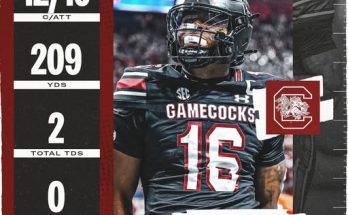Phil Steele Releases 2025 Season Forecast for Kentucky Wildcats Football, Offering Insight into Team Strengths, Key Players, and SEC Outlook.
The 2025 college football season is inching closer, and with it comes the usual wave of preseason projections from the sport’s most trusted analysts. Among the most respected in the business is Phil Steele, whose annual college football preview is widely regarded as the bible for diehard fans and insiders alike. This year, his assessment of the Kentucky Wildcats provides a comprehensive breakdown of the team’s trajectory, personnel outlook, and place within the brutal Southeastern Conference. For a program still looking to break through into the SEC elite, Steele’s analysis offers a layered picture of cautious optimism blended with familiar hurdles.
Mark Stoops enters his 13th full season as head coach, continuing to solidify his reputation as a builder and stabilizer. What he has achieved at Kentucky has long since surpassed what most thought was possible when he took over in 2013. A once-overlooked football program has developed an identity based on physical defense, line-of-scrimmage dominance, and a run-first offensive philosophy. However, that formula has yielded mixed results over the last couple of seasons, and many in the Big Blue Nation are wondering whether 2025 could be a year that reestablishes momentum.
Steele’s 2025 forecast highlights several key areas where Kentucky could find success, starting with the team’s depth and experience. The offensive line—once a dominant feature known as the “Big Blue Wall”—appears poised to regain its footing. After struggling in protection and consistency in 2023 and 2024, the line has been reshaped by both internal development and transfer additions. Steele notes that the interior of the line, in particular, has veteran leadership, while tackle play will be key to maximizing the team’s offense. If that unit holds up, the Wildcats should be able to execute Stoops’ desired physical game plan.
Under center, the quarterback situation remains a storyline to watch. Kentucky enters fall camp with a competition between returning passer Cutter Boley and transfer addition Holden Geriner, formerly of Auburn. Boley, the blue-chip prospect from Lexington, has all the tools but limited experience. Geriner offers a different style—more mobile, with SEC snaps under his belt. Steele doesn’t anoint a clear starter but suggests that the offense could function at a higher level than in recent seasons, depending on how the quarterback battle shakes out. Offensive coordinator Bush Hamdan, now in his second season, will be tasked with tailoring the scheme around whichever quarterback wins the job.
One major bright spot Steele emphasizes is the Wildcats’ running back room. Led by JuTahn McClain and true sophomore Jason Patterson, Kentucky has a one-two punch that combines physicality, speed, and versatility. McClain, a seasoned back with over 1,500 career rushing yards, is the dependable workhorse, while Patterson offers home-run ability and showed flashes of greatness in limited action last year. Depth behind them also includes transfer Barry Jackson and redshirt freshman Darius Jackson, creating one of the more underrated backfields in the SEC.
Wide receiver play has long been an inconsistent aspect of Kentucky’s offense, but 2025 could mark a shift. Dane Key and Barion Brown return as one of the most experienced duos in the league, both having played since their true freshman seasons. Steele points to their chemistry and explosiveness as a possible x-factor in opening up the offense. Brown, in particular, has game-breaking speed and is also a dangerous return specialist. If either can take the next step from solid to elite, it could be transformative for the Wildcats’ aerial attack.
On the defensive side of the ball, Steele lauds Kentucky’s linebacking corps as the heart of the unit. D’Eryk Jackson, Trevin Wallace, and Alex Afari form a trio that brings speed, strength, and leadership to the second level. Afari, who has bounced between safety and linebacker, gives the team valuable flexibility, allowing them to counter spread offenses without giving up physicality. Wallace, a likely NFL Draft pick in 2026, is the type of player who can disrupt plays sideline to sideline. Steele describes the linebackers as the “glue” that holds together a defense that otherwise has some turnover, particularly in the secondary.
In the trenches, the defensive line remains a work in progress. There is some promise in young edge rushers like Keaten Wade and Jamarius Dinkins, and Steele believes that if one or two interior linemen step up, this group could be above average. But there’s caution as well—Kentucky was middle of the pack in sacks and tackles for loss last season, and that must improve in 2025 if the defense is going to carry them against elite competition.
The secondary features new faces, especially after losing cornerstone players like Andru Phillips and Zion Childress. Transfers and new starters will be asked to play big minutes right away. Steele identifies North Texas transfer Ridge Texada and returning corner Jordan Lovett as key figures to watch. Safety play, he says, will be especially critical, given the pass-heavy nature of many SEC opponents. If the communication issues that plagued the group last season are resolved, there’s reason for moderate optimism.
Special teams has quietly been a strength for Kentucky under Stoops, and Steele doesn’t see that changing. Kicker Alex Raynor and punter Wilson Berry give the Wildcats consistency in field position and scoring opportunities. With Brown and Key returning kicks and punts, there’s always a chance for explosive plays in that phase of the game. Hidden yardage could be an asset if the offense and defense remain inconsistent at times.
Phil Steele also provides a macro-level analysis of Kentucky’s schedule, and here’s where things get tricky. The 2025 slate features road trips to Georgia, Tennessee, and Ole Miss—all ranked in Steele’s preseason Top 20—as well as a home date with Alabama. There’s also a non-conference tilt against Louisville, which has turned into a coin-flip rivalry in recent years. Steele ranks Kentucky’s schedule as one of the 15 toughest in the country, which may cap the win total ceiling, even if the team improves overall.
Still, there’s room for measured hope. Steele notes that Kentucky has won at least seven games in seven of the last eight seasons, a mark of consistency that few programs outside the SEC elite can match. In other conferences, that kind of track record might be celebrated more broadly. But in the SEC, where national titles are the standard, good is often the enemy of great. Stoops’ job security is not in question, but the hunger to compete for an SEC Championship—or even make a serious New Year’s Six run—continues to intensify.
Another storyline in Steele’s breakdown is recruiting momentum. Kentucky has cracked the Top 30 nationally in the 2025 cycle and could climb higher if a few summer targets commit. The Wildcats have consistently mined talent from Ohio, Georgia, and their own backyard, and the pipeline remains strong. Steele suggests that the staff’s ability to plug holes with transfers while continuing to build from the high school ranks is a critical long-term advantage. It’s not a flashy model, but it’s sustainable.
Steele also touches on the psychology of the program. After back-to-back seasons that fell short of expectations, how does this group respond? Leadership in the locker room, particularly from upperclassmen like McClain, Wallace, and Key, will play a role. So too will the fan base, which has grown in expectations as the program has risen in relevance. Steele doesn’t dwell on intangibles but acknowledges that in a conference as deep and unforgiving as the SEC, mental toughness is often the difference between eight wins and six.
Perhaps the most defining note in Steele’s 2025 Kentucky preview is the word “stability.” While other programs in the SEC have seen coaching turnover, scandals, or identity crises, Kentucky has remained a model of steadiness. That may not be the sexiest attribute in a sport increasingly dominated by NIL drama and transfer portal chaos, but it has value. Steele’s tone suggests that while Kentucky might not be a trendy playoff sleeper, it’s a team that could surprise if things break right.
Ultimately, Steele projects Kentucky to finish in the middle tier of the SEC, likely between 7-5 and 8-4, depending on how key position battles resolve and whether the team can stay healthy. It’s a realistic view, but one that leaves the door open for something more. In a league where chaos is the only constant, a couple of timely upsets could elevate the Wildcats into the national conversation by November.
For fans, the 2025 forecast may not offer revolutionary predictions, but it provides reassurance that Kentucky football is still firmly planted on solid ground. With playmakers returning, promising newcomers, and a head coach who knows the terrain, the Wildcats remain a program capable of punching above its weight. Phil Steele’s analysis may not light the world on fire, but in the long grind of an SEC season, sometimes steady and strong is just what a team needs to break through.



